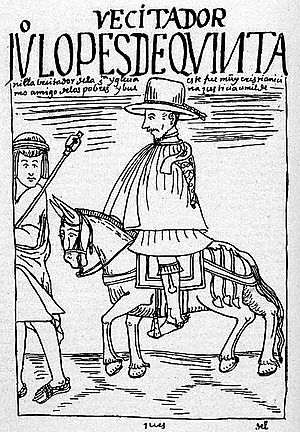Ginés de Lillo facts for kids
Ginés de Lillo (born 1566 in Murcia, died January 24, 1630, in Arauco) was an important officer in the Spanish army. In 1603, he was chosen to visit and measure lands in what is now Chile. These lands were located between the towns of Los Cauquenes and Choapa.
Contents
Why Ginés de Lillo Visited Chile
This special job was created in 1602 by Governor Alonso de Ribera. His main goal was to visit and measure lands. He looked at areas owned by both Spanish settlers and native people. This helped the Spanish government understand its control in Chile. It also helped them organize different native groups. For example, the Mapuche people were often made to work for the Spanish. This system was called encomienda, where native people worked for Spanish settlers.
Others Said No to the Job
Before Ginés de Lillo, two other people were offered this important role. Governor Alonso de Ribera first asked Juan Morales de Negrete. But Juan said no. Then, the Governor asked Melchor Jufré del Aguila. He also turned down the job. So, the title of official visitor finally went to Ginés de Lillo.
Ginés de Lillo's Work Begins
On August 21, 1603, Ginés de Lillo started his work. He began in areas like Ñuñoa, Apoquindo, Manquehue, Vitacura, Tobalaba, and Peñalolén. He then traveled into the foothills of the Andes mountains, reaching as far as Maipo. After that, he measured lands on both sides of the road from Colina and Aconcagua. He also visited Lo Negrete, Renca, and Huechuraba.
In 1604, he moved towards Tango, near the Maipo River. He also visited Chiñigue, Pomaire, Melipilla, the Puangue valley, Curacaví, Mallarauco, and Ibacache. His journey ended in Pudahuel, where he stayed with the Society of Jesus (a religious group). He then measured farms in Quilicura owned by Don Bartolomé Blumenthal. In the same year, he surveyed the Acuyo valley, from the mountains to the sea. He finished his work near Viña del Mar.
In 1605, he visited Ocoa and Quillota.
The detailed records Ginés de Lillo created were very useful for the Governor. Today, these documents are also a great source of history. They tell us about where native leaders lived in central Chile. They also show their power and the names of places. The records also explain the encomienda system and how native people were forced to move.
The Case of Bárbola de Oropesa
Bárbola de Oropesa was the widow of Don Juan, a native leader (called a Cacique) from Macul. She said she was upset about the land measurements Ginés de Lillo made in 1603. She felt she was given less land than she should have inherited. According to her, she was an easy target. She believed she lost land so that earlier unfair land deals could be corrected.
See also
In Spanish: Ginés de Lillo para niños


